
Outdoor Lighting Fundamentals
Understanding the basics of pole-mounted lighting
Introduction to Pole-Mounted Lighting
When installing outdoor pole-mounted lighting, you are looking for results that:
- Provide safety and security
- Enhance the appearance of the home or business
- Reduce your energy costs
- Are reliable and long-lasting
You will have a wide range of product choices, so it is best that you learn as much as you can from qualified, reliable sources.
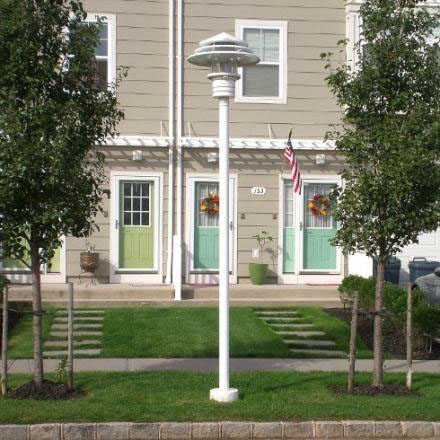
How Do I Start
It is always best to start with some goals. You should think about the space that you are trying to illuminate and consider what you want to achieve. Here are some examples of areas you should consider:
- What is the look or appearance that you are going for?
- Do you want something that is historical-looking, or something that has a modern, contemporary appearance?
- Are you lighting a long driveway in a multi-family development, or are you lighting the street entrance to a property? Perhaps you are lighting a patio or pool area. Or perhaps you are lighting a large, grassy area or park space? The lighting that you need for one type of application is not the same as the other.
- How large is the space that you are illuminating and what is its shape? Do you need to incorporate dimming controls?
- Do you have any height restrictions due to zoning or large trees that might be obstructions?
- Do you have to be concerned about proximity to the neighbors, or is the space you want to illuminate isolated from the neighbors.
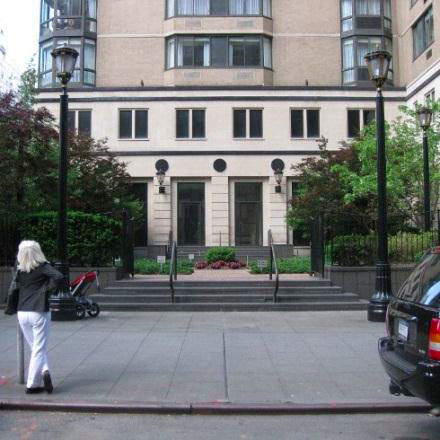
Your Budget
After you develop your lighting goals, you should take a hard look at your budget. The old adage of “You get what you pay for” is quite applicable to outdoor lighting. Smaller poles and light fixtures that are typically sourced from a home improvement center or a lighting showroom are often at the lower end of the price scale. The professional-grade, longlasting lighting products that are often seen in city parks or commercial settings are at the higher end of the price scale. But you should know that the quality varies greatly between the lower end and higher end. An outdoor environment can be quite harsh, and the upfront investment you make in professional-grade products will pay dividends.
New, Retrofit, or Replacement
With a new lighting installation, you will have many product choices and a lot of flexibility. These product choices can be daunting, but by setting goals and creating a budget, you will soon begin to zero in on what you want. If you are retrofitting or replacing lighting equipment, you may end up facing restrictions, as you are trying to make something new fit onto or into a particular space. For example, will you be able to install a replacement light fixture onto an existing light pole? Will it be secured correctly? Will it be aesthetically pleasing?
The Basics of Pole-Mounted Light Fixtures
Types of Pole-Mounted Light Fixtures
Pole-mounted light fixtures are either post-top style or pendant-mounted style. Within these two general categories, you will find fixture types that the lighting industry may call Acorns, Lanterns, Tulips, Ball Globes, and so on. Functionally-speaking, they are generally similar. From an aesthetic viewpoint, they are very different.

Types of Light Sources Used In Light Fixtures
Professional-grade light fixtures can be configured with many types of light sources. Here are just a few:
LED (Light Emitting Diode): We are now seeing LEDs becoming the dominant light source for new installations. LED light fixtures have many advantages. Most notably, they consume less energy and last for many years, so maintenance is significantly reduced. LED replacement lamps are readily available, but the best performing and most reliable light fixtures will have LED light sources as factory-installed components.
High Intensity Discharge (HID): HID light sources were the de facto standard for many decades and still see use in professional-grade light fixtures. LED lighting is slowly displacing HID lighting. The two most common HID sources are Metal Halide and High Pressure Sodium. For homes, Metal Halide is preferable.
Compact Fluorescent: These will provide only a small-to-modest amount of light, and will not be as long-lasting as LED or HID. In cold temperature, their light output can be severely diminished.
Incandescent: This light source provides a small amount of light when compared to other light sources, and it is not as energy efficient. The lamp will fail in a shorter period of time, which requires more frequent maintenance. Incandescent may be best suited for small post lights or porch lights.
Types of Light Distributions (The Shape of Light)
Professional-grade light fixtures can be designed to distribute the light in several different patterns. This allows the homeowner to direct the light where it is needed, and thus provides improved efficiency. The two most common light distributions, Type V and Type III, are shown below. Type V would be used for large open spaces, as the light is distributed in all directions. Type III would typically be used along streets, pathways, and driveways, as more light is directed to one side of the light fixture than the other.

How Much Light Do I Need?
The amount of light required to illuminate an intended area can vary widely depending upon many factors such as type of light fixture, the specifications of the light source, the mounting height of the light fixture, etc. The lighting industry does publish recommended practices, which can be challenging to understand and apply correctly. When in doubt, it is always best to seek guidance from knowledgeable lighting professionals.
The Basics of Light Poles
Decorative Versus Non-Decorative
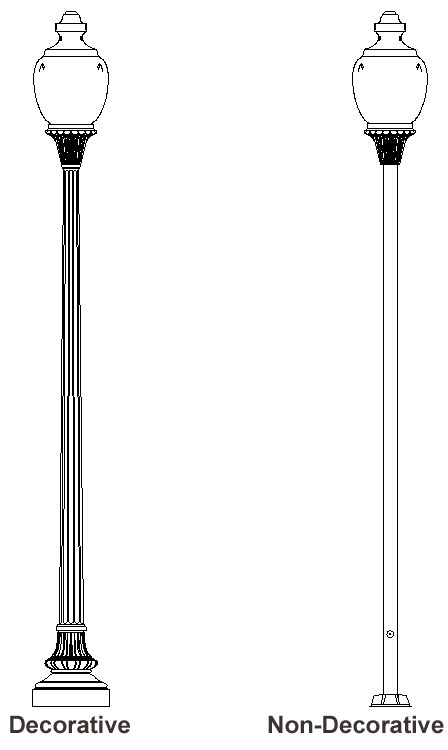
There is a stark difference between decorative and non-decorative poles. It is always best if the ornate styling of a decorative pole complements the styling of the light fixture. The images shown at right illustrate the differences of the two pole types, each 10’ in height.
Pole Height
The pole height is, to a large part, determined by the light output of the light source, the size of the intended area of illumination, and aesthetic factors. When using light fixtures that emit higher amounts of light, or when illuminating large areas, the poles should be taller in height. This provides more uniform lighting and reduces the discomfort of glare. It is not uncommon to see poles mounted between 10’ and 14’.
Another factor is the scale of the light fixture versus the height of a pole. For example, you would not want to place a small light fixture up very high. It might not function very well, and it would look out of scale. Vice versa, placing a larger fixture on a short pole (i.e. 5’ to 7’) might also look out of scale.
The Aesthetics of Decorative Poles
When purchasing decorative poles, you will have to determine which decorative features you want. The bottom portion of the pole (i.e. base) will take on different shapes and have various floral designs, flutes, and other decorative features. The upper portion of the pole (i.e. shaft) can be plain, tapered, or fluted. These decorative elements should complement the decorative style of the light fixture and also be a fit for its surroundings.
Cast Aluminum versus Cast Iron
Decorative poles will often be available in both cast aluminum and cast iron. Both are high strength, durable materials. Both can be purchased with a variety of paint finishes. With aluminum, you are getting a lighter weight pole that is easier to install, easier to transport, and has more choices of shaft design and height. With cast iron, you are getting a heavier, more robust product with a more authentic historical finish.
Securing and Anchoring Light Poles
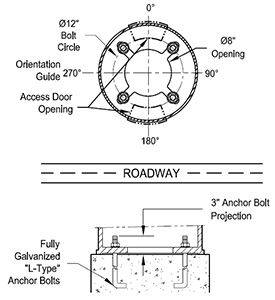
The first method for securing poles is called “direct burial”, where a pole has an extension portion that is placed in a hole in the ground, and then the hole is back-filled. The second method, which is more reliable and common, is with the use of anchor bolts (see illustrations at right). With the aid of a manufacturer-supplied template, the anchor bolts are secured into a concrete base. The ends of the anchor bolts protrude several inches above grade, and the pole is placed over the anchor bolts. Heavy duty washers and hex nuts then secure the pole to the anchor bolts.
Other Types of Mounting for Light Fixtures
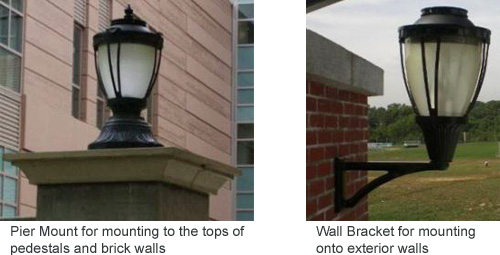
Light Guide content provided by Sentry Electric LLC, Freeport, NY
www.SentryLighting.com
©2015 Sentry Electric LLC. All Rights Reserved.

